Geochemistry, Zircon U–Pb Geochronology, and Lu–Hf Isotopes of the Chishan Alkaline Complex, Western Shandong, China
Abstract
1. Introduction
2. Regional Geology
3. Petrology and Petrography
4. Samples and Analysis
4.1. Total Rock Major and Trace Element Analysis
4.2. Zircon U–Pb Dating
4.3. Zircon Lu–Hf Isotopes
5. Results
5.1. Analysis Results of Total Rock Major and Trace Elements
5.2. Zircon U–Pb Dating
5.3. Zircon Lu–Hf Dating
6. Discussion
6.1. Rock Ages
6.2. Magmatic Sources and Evolution
6.3. Tectonic Setting
7. Conclusions
Author Contributions
Funding
Acknowledgments
Conflicts of Interest
References
- Deng, J.F.; Mo, X.X.; Zhao, H.L.; Luo, Z.H.; Du, Y.S. Lithospheric root/de-rooting and activation. J. Grad. Sch. China Univ. Geosci. 1994, 8, 350–356, (In Chinese with English abstract). [Google Scholar]
- Deng, J.F.; Zhao, H.L.; Mo, X.X.; Wu, Z.X.; Luo, Z.H. Continental Roots-Plume Tectonics of China—Key to the Continental Dynamics; Geological Publishing House: Beijing, China, 1996; pp. 1–110. (In Chinese) [Google Scholar]
- Wu, F.Y.; Sun, D.Y.; Lin, Q. Petrogenesis of the Phanerozoic granites and crustal growth in the Northeast China. Acta Pet. Sin. 1999, 15, 181–189, (In Chinese with English abstract). [Google Scholar]
- Wu, F.Y.; Sun, D.Y. The Mesozoic magmatism and lithospheric thinning in the eastern China. J. Chang. Univ. Sci. Tech. 1999, 29, 313–318, (In Chinese with English abstract). [Google Scholar]
- Shao, J.A.; Liu, F.T.; Chen, H.; Han, Q.J. Relationship between Mesozoic magmatism and subduction in Da Hinggan-Yanshan Area. Acta Geol. Sin. 2001, 75, 56–63, (In Chinese with English abstract). [Google Scholar]
- Zhang, Q.; Wang, Y.; Yang, J.H.; Wang, Y.L.; Zhao, T.P.; Guo, G.J. The Characteristics and tectonic-metallogenetic significances of the adakites in the Yanshanian Period from eastern China. Acta Pet. Sin. 2001, 17, 236–244, (In Chinese with English abstract). [Google Scholar]
- Zhang, Q.; Wang, Y.; Wang, Y.L. Preliminary study on the components of the lower crust in east China plateau during Yanshanian period: Constraints on Sr and Nd isotopic compositions of adakite-like rocks. Acta Pet. Sin. 2001, 17, 505–513, (In Chinese with English abstract). [Google Scholar]
- Zhai, M.G.; Fan, Q.C. Mesozoic replacement of bottom crust in North China Craton: An orogenic mantle-crust interaction. Acta Pet. Sin. 2002, 18, 1–8, (In Chinese with English abstract). [Google Scholar]
- Hu, S.X.; Zao, Y.Y.; Hu, Z.H.; Guo, J.C.; Xu, B. Evolution and decelopment of tectonics and magmatism at the active continental margin of the East China(E106°) during Mesozoic and Cenozoic. Acta Pet. Sin. 1994, 10, 370–381. [Google Scholar]
- Chen, Y.J.; Guo, Y.J.; Guo, G.J.; Li, X. Metallogenic geodynamic background of Mesozoic gold deposits in the huabei craton granite greenstone terrane. Sci. China Earth Sci. 1998, 28, 35–40. [Google Scholar]
- Mao, J.W.; Zhang, Z.H.; Yu, J.J.; Wang, Y.T.; Niu, B.G. Geodynamics of Mesozoic large-scale mineralization in north China and its adjacent areas: implications from precise dating of metallic deposit. Sci. China Earth Sci. 2003, 4, 289–299. [Google Scholar]
- Li, J.W.; Bi, S.J.; Selby, D.; Chen, L.; Vasconcelos, P.; Thiede, D.; Zhou, M.F.; Zhao, X.F.; Li, Z.K.; Qiu, H.Z. Giant Mesozoic gold procinces related to the destruction of the North China carton. Earth Planet Sci. Lett. 2012, 349–350, 26–37. [Google Scholar] [CrossRef]
- Zhai, M.; Santosh, M. Metallogeny of the North China carton: Link with secular changes in the evolving Earth. Gondwana Res. 2013, 24, 275–297. [Google Scholar] [CrossRef]
- Chen, Y.J.; Franco, P.; Lai, Y.; Li, C. Metallogenic time and tectonic setting of the Jiaodong gold province, eastern China. Acta Pet. Sin. 2004, 20, 907–922. [Google Scholar]
- Mao, J.W.; Pirajno, F.; Xiang, J.F.; Gao, J.J.; Ye, H.S.; Li, Y.F.; Guo, B.J. Mesozoic molybdenum deposits in the east Qinling-Dabie oro-genic belt: Characteristics and tectonic settings. Ore Geol. Rev. 2011, 43, 264–293. [Google Scholar] [CrossRef]
- Goldfarb, R.J.; Santosh, M. The dilemma of the Jiaodong gold deposits: Are they unique? Geosci. Front. 2014, 5, 139–153. [Google Scholar] [CrossRef]
- Yang, J.H.; Zhou, X.H. Rb–Sr, Sm–Nd and Pb isotope systematics of pyrite: implications for the age and genesis of lode gold deposits. Geology 2001, 29, 711–714. [Google Scholar] [CrossRef]
- Chen, Y.J.; Pirajno, F.; Qi, J.P. Origin of gold metallogeny and sources of ore-forming fluids, in the Jiaodong province, eatern China. Int. Geol. Rev. 2005, 47, 530–549. [Google Scholar] [CrossRef]
- Li, J.J.; Luo, Z.K.; Liu, X.Y.; Xu, W.D.; Chen, A.S. The zircon Shrimp U–Pb age of the granite–porphyry veins after mineralization in linglong gold deposit restricts the evolution of the Jiaobei terrains. Earth Sci. Front. 2005, 12, 317–324. [Google Scholar]
- Wu, F.Y.; Lin, J.Q.; Wilde, S.A.; Zhang, X.; Yang, J.H. Nature and significance of the Early Cretaceous giant igneous event in eastern China. Earth Planet. Sci. Lett. 2005, 233, 103–119. [Google Scholar] [CrossRef]
- Hou, M.L.; Jiang, S.Y.; Jiang, Y.H.; Li, H.F. S–Pb isotope geochemistry and Rb–Sr geochronology of the Penglai gold field in the eastem Shangdong province. Acta Pet. Sin. 2006, 22, 2525–2533, (In Chinese with English abstrcat). [Google Scholar]
- Jiang, S.Y.; Dai, B.Z.; Jiang, Y.H.; Zhao, H.X.; Hou, M.L. Jiaodong and Xiaoqinling: Two orogenic gold provinces formed in different tectonic settings. Acta Pet. Sin. 2009, 25, 2727–2738, (In Chinese with English abstract). [Google Scholar]
- Lan, T.G.; Fan, H.R.; Santosh, M.; Hu, F.F.; Yang, K.F.; Yang, Y.H. Early Jurassic high-K calc-alkaline and shoshonitic rocks from the Tongshi intrusive complex, eastern North China Craton: Implication for crust-mantle interaction and post-collisional magmatism. Lithos 2012, 140–141, 183–199. [Google Scholar] [CrossRef]
- Tian, J.X.; Li, X.X.; Song, Z.Z.; Liu, H.D.; Huang, Y.B.; Zhu, D.C. Environment, formation age and material sources of Mesozoic Gold deposits in Western Shandong: A Synthesis. Acta Geol. Sin. 2015, 89, 1530–1537. [Google Scholar]
- Tian, J.X.; Zhang, R.T.; Fan, Y.C.; Li, X.Z.; Xu, H.Y.; Wang, B.Y. Geological characteristics and relation with rare earth elements of alkalic complex in Chishan of Shandong Province. Shandong Geol. 2002, 18, 21–25. [Google Scholar]
- Kong, Q.Y.; Li, J.K.; Yu, X.F. Shandong Deposit; Shandong Science & Technology Press: Jinan, China, 2006; pp. 1–902. [Google Scholar]
- Yan, G.H.; Cai, J.H.; Ren, K.X.; Mu, B.L.; Chu, Z.Y. Nd, Sr and Pb isotopic geochemistry of late-Mesozoic alkaline-rich intrusions from the Tanlu Fault zone: evidence of the magma soucre. Acta Pet. Sin. 2008, 24, 1223–1236. [Google Scholar]
- Yu, X.F.; Tang, H.S.; Han, Z.Z.; Li, C.Y. Geological characteristics and origin of rare earth elements deposits related with alkaline rock in the Chishan-Longbaoshan area, Shandong Province. Acta Geol. Sin. 2010, 84, 407–417. [Google Scholar]
- Yuan, Z.X.; Li, J.K.; Wang, D.H.; Zheng, G.D.; Lou, D.B.; Chen, Z.H.; Zhao, Z.; Yu, Y. Metallogenetic Regularity of Rare Earth Deposits in China; Geological Publishing House: Beijing, China, 2012; pp. 1–116. [Google Scholar]
- Wang, J.F.; Sun, M.T.; Du, X.B.; Gan, Y.J.; Zhang, G.Q.; Wang, Z.L. Geological characteristics and prospecting potentiality of Xishan rare earth deposit in Shandong Province. Shandong Land Res. 2016, 32, 32–40. [Google Scholar]
- Li, J.K.; Yuan, Z.X.; Bai, G.; Chen, Y.C.; Wang, D.H.; Ying, L.J.; Zhang, J. Ore-forming fluid evolvement and its controlling to REE (AG) mineralizing in the Weishan deposit, Shandong. J. Min. Pet. 2009, 29, 60–68. [Google Scholar]
- Lan, T.G.; Fan, H.R.; Hu, F.F.; Yang, K.F.; Wang, Y. Genesis of the Weishan REE deposit, Shandong Province: Evidences from Rb–Sr isochron age, LA-MC-ICPMS Nd isotopic compositions and fluid inclusions. Geochimica 2011, 40, 428–442. [Google Scholar]
- Zhou, W.W.; Cai, J.H.; Yan, G.H. The geochemical characteristics and geological significance of alkaline complex in Chishan of Shandong Province. Northwestern Geol. 2013, 46, 93–105. [Google Scholar]
- Yu, X.F.; Tang, H.S.; Li, D.P. Study on the Mineralization of Chishan Rare Earth Element Deposit Related to Alkaline Rock, Shandong Province. Acta Geol. Sin. (Engl. Ed.) 2014, 88, 480–481. [Google Scholar] [CrossRef]
- Liang, Y.W.; Lai, Y.; Hu, H.; Zhang, F. Zircon U–Pb Ages and Geochemical Characteristics Study of Syenite from Weishan REE Deposit, Western Shandong. Acta Sci. Nat. Univ. Pekin 2017, 53, 652–666. [Google Scholar]
- Zhu, G.; Liu, G.S.; Niu, M.L.; Song, C.Z.; Wang, D.X. Transcurrent movement and genesis of the Tan–Lu Fault Zone. Geol. Bull. China 2003, 22, 200–207, (In Chinese with English abstract). [Google Scholar]
- Zhang, X.M.; Zhang, Y.Q.; Ji, W. Fault distribution patterns of the Luxi Block, Shandong, and Mesozoic sedimentary–magmatic–structural evolution sequence. J. Geomech. 2007, 13, 163–172, (In Chinese with English abstract). [Google Scholar]
- Chen, L.; Tao, W.; Zhao, L.; Zhen, T.Y. Distinct lateral variation of lithospheric thickness in the Northeastern North China Craton. Earth Planet. Sci. Lett. 2008, 267, 56–68. [Google Scholar] [CrossRef]
- Zhao, G.; Wilde, S.A.; Guo, J.H.; Cawood, P.A.; Sun, M.; Li, X.P. Single zircon grains record two Paleoproterozoic collisional events in the North China Craton. Precambrian Res. 2010, 177, 266–276. [Google Scholar] [CrossRef]
- Zhao, G.C.; Wilde, S.A.; Cawood, P.A.; Sun, M. Archean blocks and their boundaries in the North China Craton: Lithological, geochemical, structural and P–T pathconstraints and tectonic evolution. Precambrian Res. 2001, 107, 45–73. [Google Scholar] [CrossRef]
- Li, J.; Jin, A.; Hou, G. Timing and implications for the late Mesozoic geodynamic settings of eastern North China Craton: Evidences from K-Ar dating age and sedimentary-structural characteristics records of Lingshan Island, Shandong Province. J. Earth Syst. Sci. 2017, 126, 117. [Google Scholar] [CrossRef]
- Wang, S.J.; Li, X.P.; Schertl, H.P.; Feng, Q.D. Petrogenesis of early cretaceous andesite dykes in the Sulu orogenic belt, eastern China. Mineral. Petrol. 2019, 113, 77–97. [Google Scholar] [CrossRef]
- Li, R.; Albert, N.N.; Yun, M.; Meng, Y.; Du, H. Geological and Geochemical Characteristics of the Archean Basement-Hosted Gold Deposit in Pinglidian, Jiaodong Peninsula, Eastern China: Constraints on Auriferous Quartz-Vein Exploration. Minerals 2019, 9, 62. [Google Scholar] [CrossRef]
- Han, C.; Han, M.; Jiang, Z.X.; Han, Z.Z.; Li, H.; Song, Z.G.; Zhong, W.J.; Liu, K.X.; Wang, C.H. Source analysis of quartz from the Upper Ordovician and Lower Silurian black shale and its effects on shale gas reservoir in the Southern Sichuan Basin and its periphery, China. Geol. J 2019, 54, 439–449. [Google Scholar] [CrossRef]
- Wang, J.; Wang, X.; Liu, J.; Liu, Z.; Zhai, D.; Wang, Y. Geology, geochemistry, and geochronology of gabbro from the Haoyaoerhudong gold deposit, Northern Margin of the North China Craton. Minerals 2019, 9, 63. [Google Scholar] [CrossRef]
- Kong, Q.Y.; Zhang, T.Z.; Yu, X.F.; Xu, J.X.; Pan, Y.L.; Li, X.S. Deposits in Shandong Province; Shandong Science and Technology Press: Jinan, China, 2006; pp. 1–902. (In Chinese) [Google Scholar]
- Song, B.; Zhang, Y.H.; Wan, Y.S.; Jian, P. Mount Making and procedure of the SHRIMP Dating. Geol. Rev. 2002, 48, 26–30, (In Chinese with English abstract). [Google Scholar]
- Yuan, H.; Gao, S.; Liu, X.; Li, H.; Günther, D.; Wu, F. Accurate U–Pb age and trace element determinations of zircon by laser ablation-inductively coupled plasma-mass spectrometry. Geostand. Geoanal. Res. 2010, 28, 353–370. [Google Scholar] [CrossRef]
- Liu, Y.S.; Hu, Z.C.; Gao, S.; Xu, J.; Gao, C.G.; Chen, H.H. In suit analysis of major and trace elements of anhydrous minerals by LA-ICP-MS without applying an internal standard. Chem. Geol. 2008, 257, 34–43. [Google Scholar] [CrossRef]
- Ludwig, K.R. User’s Manual for Isoplot 3.70, A Geolocro-Nological Toolkit for Microsoft Excel; Berkeley Geochronology Center Special Publication: Berkeley, CA, USA, 2003; Volume 4, pp. 25–32. [Google Scholar]
- Geng, J.Z.; Li, H.K.; Zhang, J.; Zhou, H.Y.; Li, H.M. Zircon Hf isotope analysis by means of LA-MC-ICP-MS. Geol. Bull. China 2011, 30, 1508–1513, (In Chinese with English abstract). [Google Scholar]
- Soderlund, U.; Patchett, P.J.; Vervoort, J.D.; Isachsen, C.E. The 176Lu decay constant determined by Lu-Hf and U-Pb isotope systematics of Precambrian mafic instrusions. Earth Planet Sci. Lett. 2004, 219, 311–324. [Google Scholar] [CrossRef]
- Bichert-Toft, J.; Albarede, F. The Lu–Hf geochemistry of chondrites and the evolution of the mantle-crust system. Earth Planet. Sci. Lett. 1997, 148, 243–258. [Google Scholar] [CrossRef]
- Griffin, W.L.; Pearson, N.J.; Belousova, E.; Jackson, S.E.; Achterbergh, E.V.; O’Reilly, S.Y.; Shee, S.R. The Hf isotope composition of cratonic mantle: LAM-MC-ICPMS analysis of zircon megacrysts in kimberlites. Geochim. Cosmochim. Acta. 2000, 64, 133–147. [Google Scholar] [CrossRef]
- Wu, F.Y.; Li, X.H.; Zheng, Y.F.; Gao, S. Lu–Hf isotopic systematics and their applications in petrology. Acta Pet. Sin. 2007, 23, 185–220, (In Chinese with English abstract). [Google Scholar]
- Middlemost, E.A.K. Naming materials in the magma/igneous rock system. Earth Sci. Rev. 1994, 37, 215–224. [Google Scholar] [CrossRef]
- Wright, J.B. A simple alkalinity ratio and its application to questions of nonorogenic granite genesis. Geol. Mag. 1969, 106, 370–384. [Google Scholar] [CrossRef]
- Peccerillo, A.; Taylor, S.R. Geochemistry of Eocene calc-alkaline volcanic rocks from the Kastamonu, northern Turkey. Contrib. Mineral. Petrol. 1976, 58, 63–81. [Google Scholar] [CrossRef]
- Sun, S.S.; McDonough, W.F. Chemical and isotopic systematics of oceanic basalts: implications for mantle composition and processes. In Magmatism in the Oceanic Basalts; Saunders, A.D., Norry, M.J., Eds.; Geological Society Special Publication: London, UK, 1989; pp. 313–345. [Google Scholar]
- Vervootr, J.D.; Patchett, P.J.; Gehrels, G.E.; Nutman, A.P. Constraints on Earth differentiation from hafnium and neodymium. Nature 1996, 379, 624–627. [Google Scholar]
- Guo, P. A Study on the Geodynamic Background of Mesozoic Gold Mineralization in Western Shandong. Ph.D. Thesis, China University of Geosciences (Beijing), Beijing, China, 2014. [Google Scholar]
- Wilson, M. Igneous Petrogenesis: Agobal Tectonic Approach; Unwin Hyman: London, UK, 1989; pp. 1–466. [Google Scholar]
- Kinny, P.D. Lu–Hf and Sm–Nd isotope systems in zircon. Rev. Mineral. Geochem. 2003, 53, 327–341. [Google Scholar] [CrossRef]
- Sui, Z.M.; Ge, W.C.; Wu, F.Y.; Xu, X.C.; Zhang, J.H. Hf isotopic characteristics and geological significance of the Chahayan Pluton in northern Daxing´anling Mountains. J. Jilin Univ. Earth Sci. Ed. 2009, 39, 849–867, (In Chinese with English abstract). [Google Scholar]
- Lan, T.G.; Fan, H.R.; Hu, F.F.; Tomkins, A.G.; Yang, K.F.; Liu, Y. Multiple crust-mantle interactions for the destruction of the north china craton: Geochemical and Sr–Nd–Pb–Hf isotopic evidence from the longbaoshan alkaline complex. Lithos 2011, 122, 87–106. [Google Scholar] [CrossRef]
- Xu, Y.G. Thermo-tectonic destruction of the Archean lithospheric keel beneath the Sino-Korean Craton: Evidence, timing and mechanism. Phys. Chem. Earth Part A Solid Earth Geod. 2001, 26, 747–757. [Google Scholar] [CrossRef]
- Xu, Y.G.; Huang, X.L.; Ma, J.L.; Wang, Y.B.; Iizuka, Y.; Xu, J.F. Crust-mantle interaction during the tectono-thermal reactivation of the North China Craton: constraints from SHRIMP zircon U–Pb chronology and geochemistry of Mesozoic plutons from western Shandong. Contrib. Mineral. Petrol. 2004, 147, 750–767. [Google Scholar] [CrossRef]
- Xu, Y.G.; Ma, J.L.; Huang, X.L.; Iizuka, Y.; Chung, S.L.; Wang, Y.B.; Wu, X.Y. Early Cretaceous gabbroic complex from Yinan, Shandong Province: petrogenesis and mantle domains beneath the North China Craton. Int. J. Earth Sci. 2004, 93, 1025–1041. [Google Scholar] [CrossRef]
- Zhang, H.F.; Sun, M.; Zhou, X.H.; Fan, W.M.; Zhai, M.G.; Yin, J.F. Mesozoic lithosphere destruction beneath the North China Craton: Evidence from major-trace-element and Sr–Nd–Pb isotope studies of Fangcheng basalts. Contrib. Mineral. Petrol. 2002, 144, 241–253. [Google Scholar] [CrossRef]
- Xu, G.Z.; Zhou, R.; Wang, Y.F.; She, H.Q.; Li, B.; Du, B.M.; Song, M.C. The intrinsic factors causing the significant differences in Mesozoic mineralization between Jiaodong and Luxi areas. Geoscience 2002, 16, 9–18, (In Chinese with English abstract). [Google Scholar]
- Li, Z.X. Collision between the North and South China Blocks: a Crustal-detachment model for the suturing in the region east of the Tanlu fault. Geology 1994, 22, 739–742. [Google Scholar] [CrossRef]
- Hu, H.B.; Mao, J.W.; Niu, S.Y.; Li, Y.F.; Li, M.W. Geology and geochemistry of telluride-bearing Au deposits in the Pingyi area, Western Shandong, China. Mineral. Petrol. 2006, 87, 209–240. [Google Scholar] [CrossRef]
- Chen, Y.J.; Zhai, M.G.; Jiang, S.Y. Significant achievements and open issues in study of orogenesis and metallogenesis surrounding the North China continent. Acta Pet. Sin. 2009, 25, 2695–2726. [Google Scholar]
- Dong, G.; Santosh, M.; Li, S.; Shen, J.; Mo, X.; Scott, S. Mesozoic magmatism and metallogenesis associated with the destruction of the North China Craton: Evidence from U–Pb geochronology and stable isotope geochemistry of the Mujicun porphyry Cu–Mo deposit. Ore Geol. Rev. 2013, 53, 434–445. [Google Scholar] [CrossRef]
- Brown, G.C. Calcalkaline Intrusive Rocks: Their Diversity, Evolution and Relation to Volcanic Arcs; John Wiley & Sons Inc.: Hoboken, NJ, USA, 1982; pp. 437–461. [Google Scholar]
- Pearce, J.A. Source and settings of granite genesis. Geol. Mag. 1969, 106, 370–384. [Google Scholar]
- Zhao, Z.H. Use the trace element diagram to discriminate tectonic settings. Geotectonica Et Metalogenia 2007, 31, 92–103. [Google Scholar]
- Wu, F.Y.; Sun, D.Y.; Zhang, G.L.; Ren, X.W. Deep geodynamics of Yanshain Movement. Geol. J. China Univ. 2000, 6, 379–388. [Google Scholar]
- Hong, D.W.; Wang, T.; Tong, Y.; Wang, X.X. Break-up of the North China Craton through Lithospheric Thinning. Earth Sci. Front. 2003, 10, 232–249. [Google Scholar]
- Zhou, X.H.; Zhang, H.F. High chemical heterogeneity of lithospheric mantle and continental lithospheric transition in north China during Mesozoic. Earth Sci. J. China Univ. Geosci. 2006, 31, 8–13. [Google Scholar]
- Ji, S.C.; Wan, Q.; Xu, Z.Q. Break-up of the North China Craton through Lithospheric Thinning. Acta Geol. Sin. 2008, 82, 175–193. [Google Scholar]
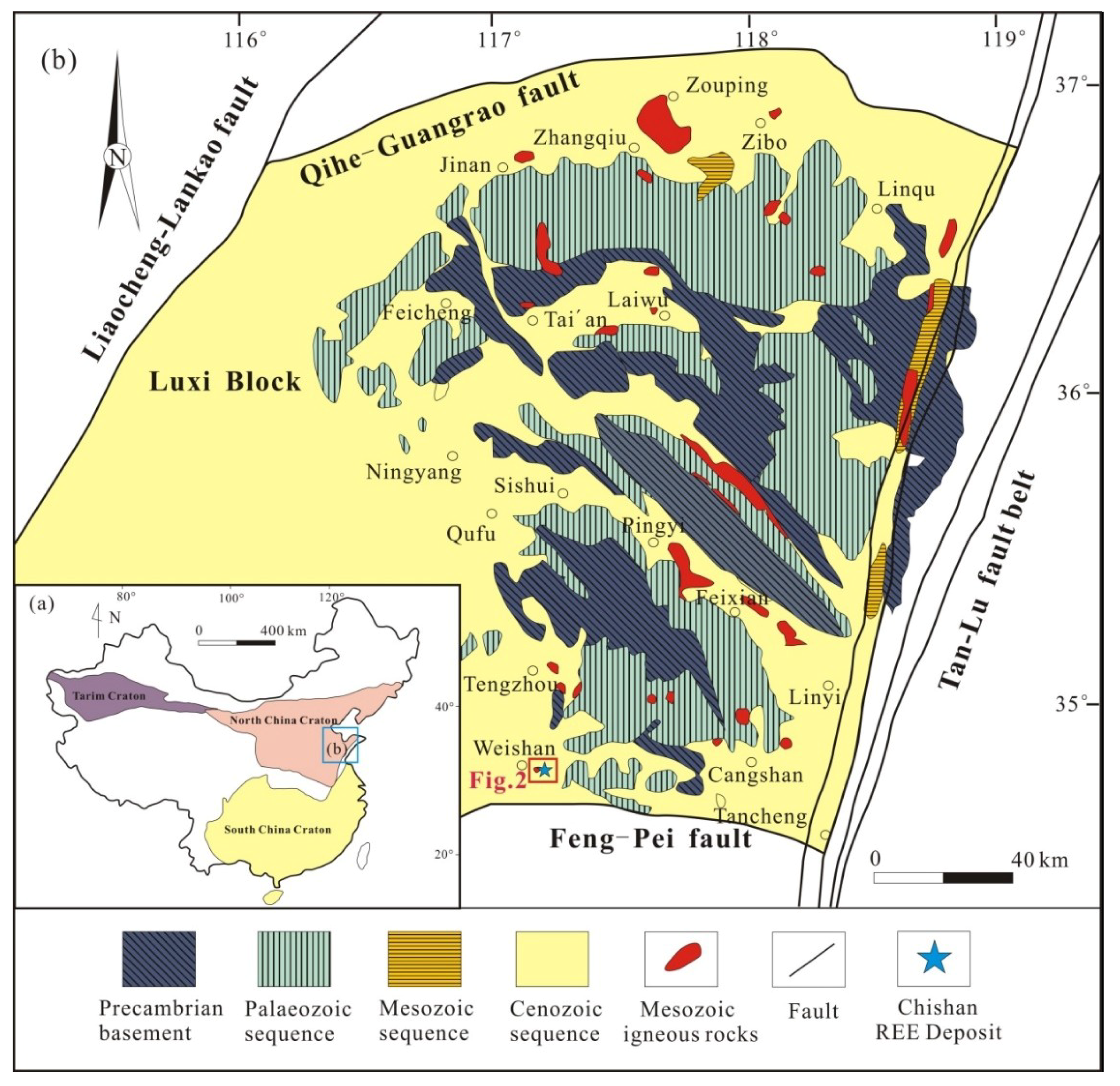
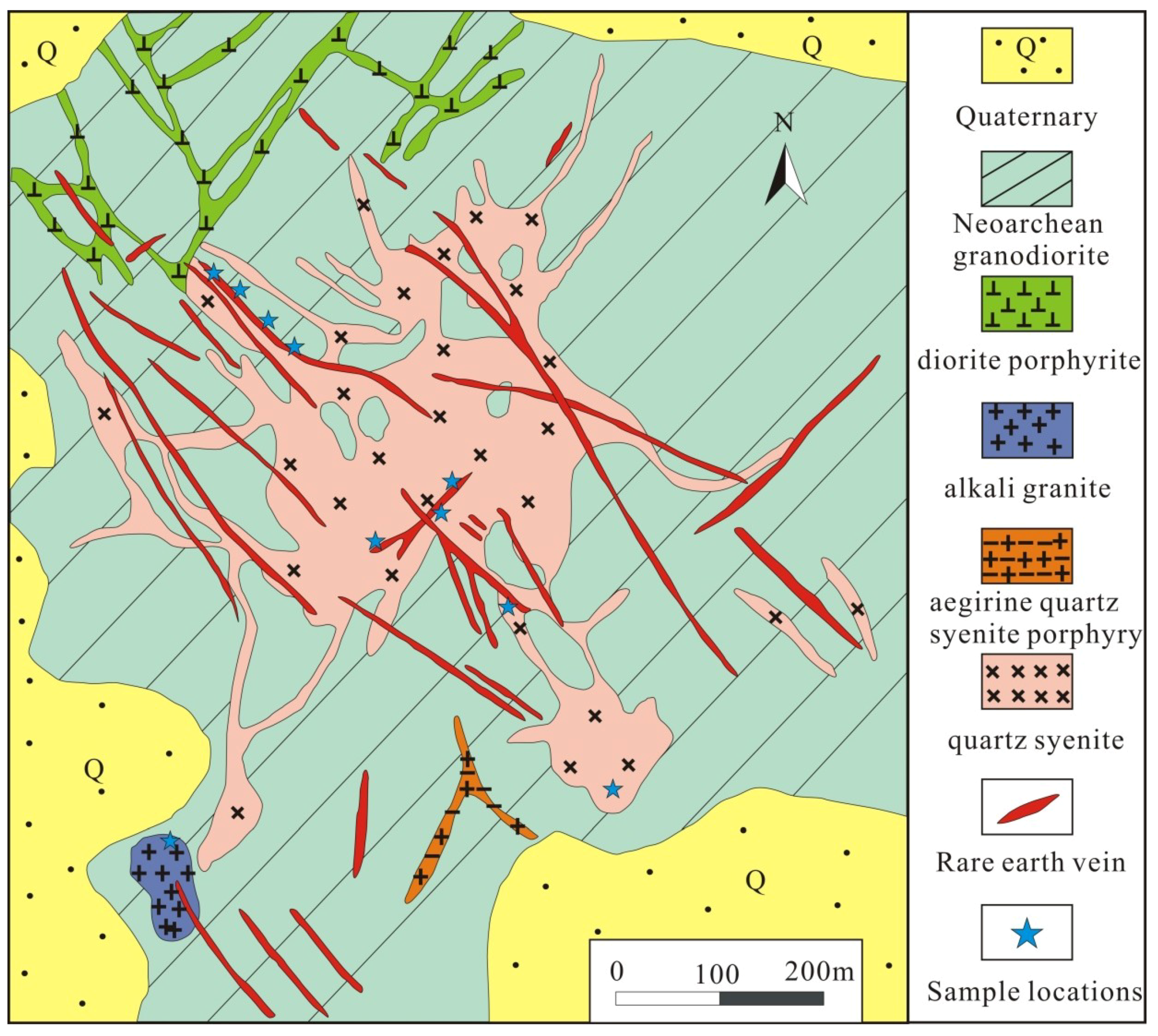
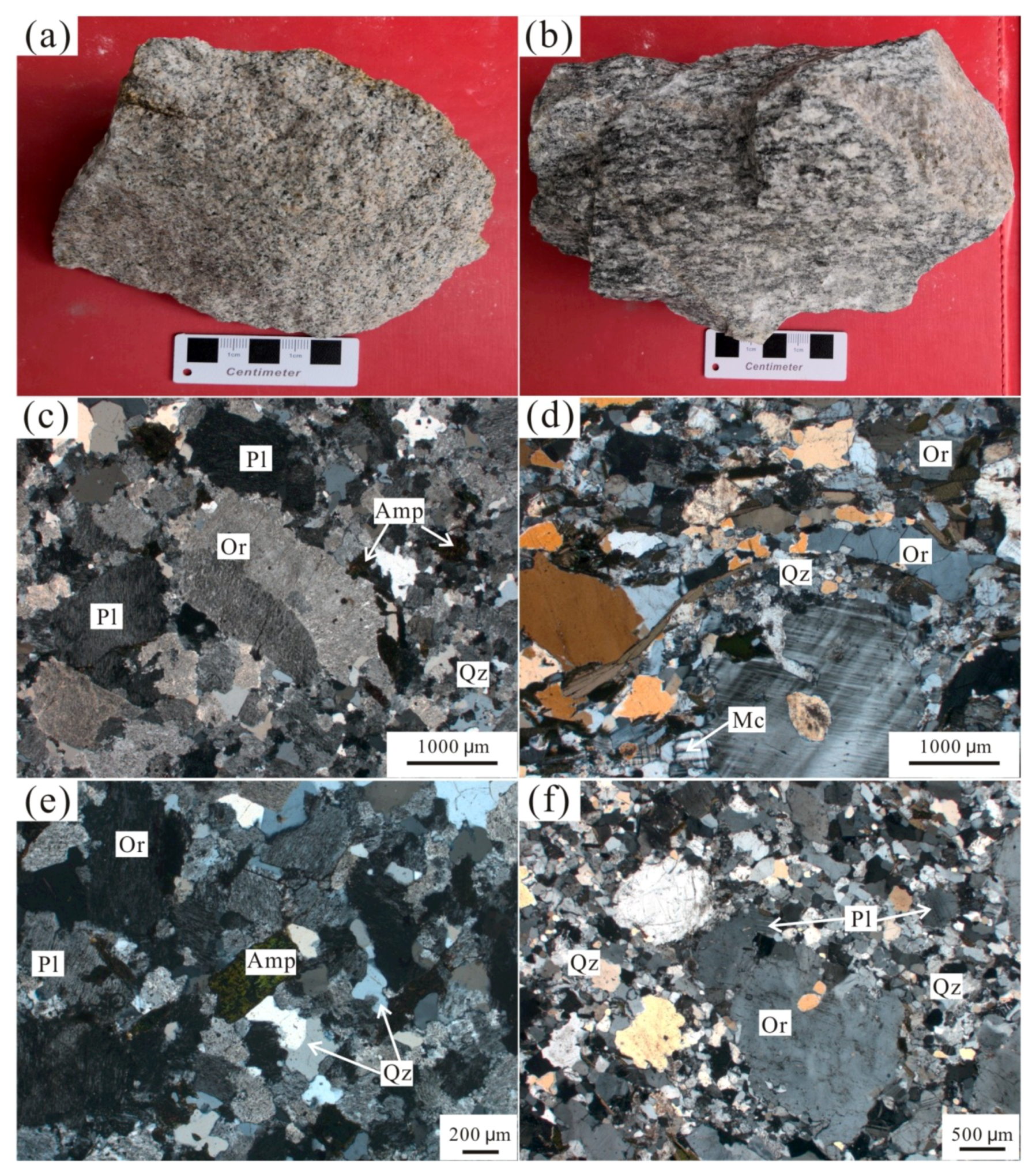
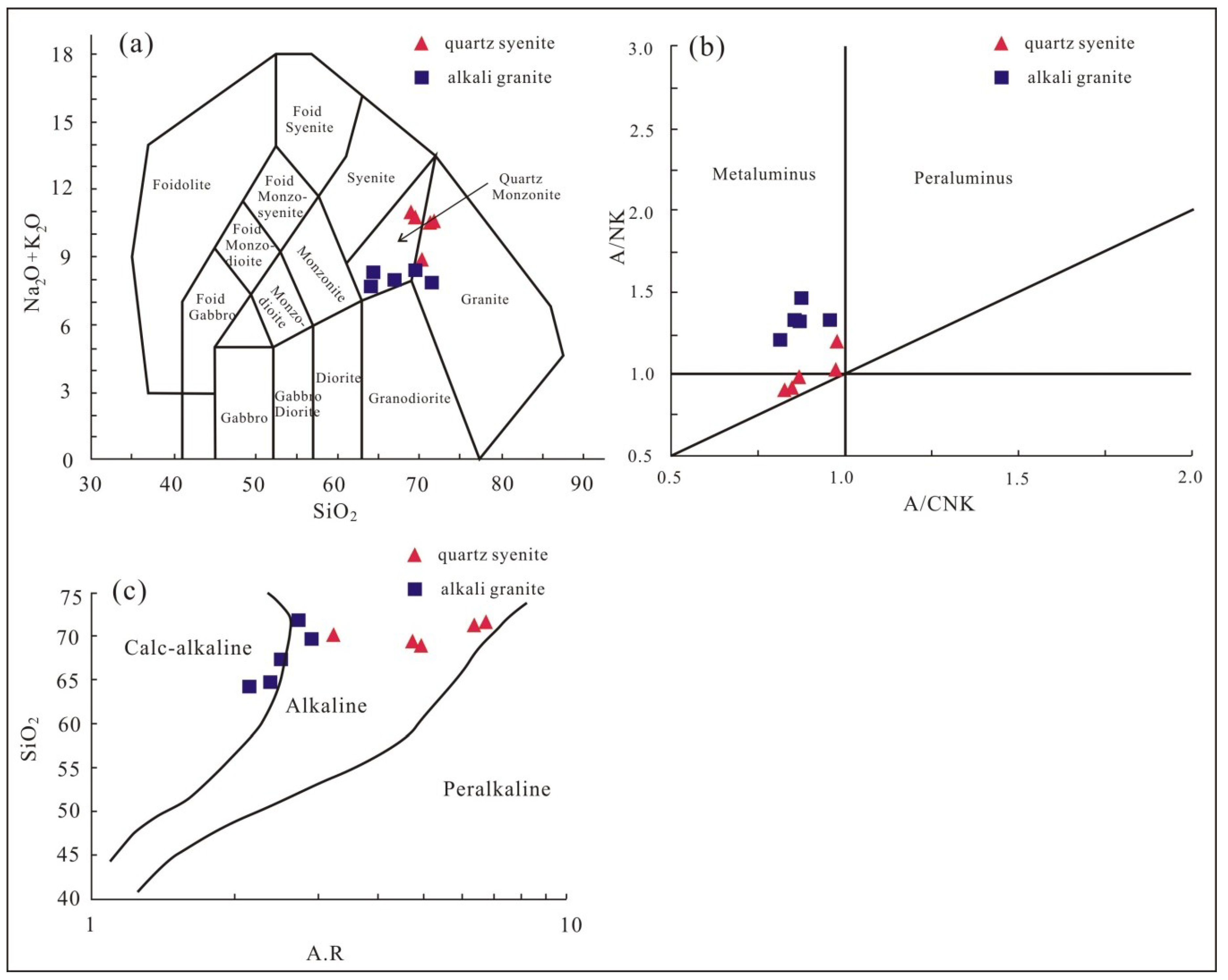
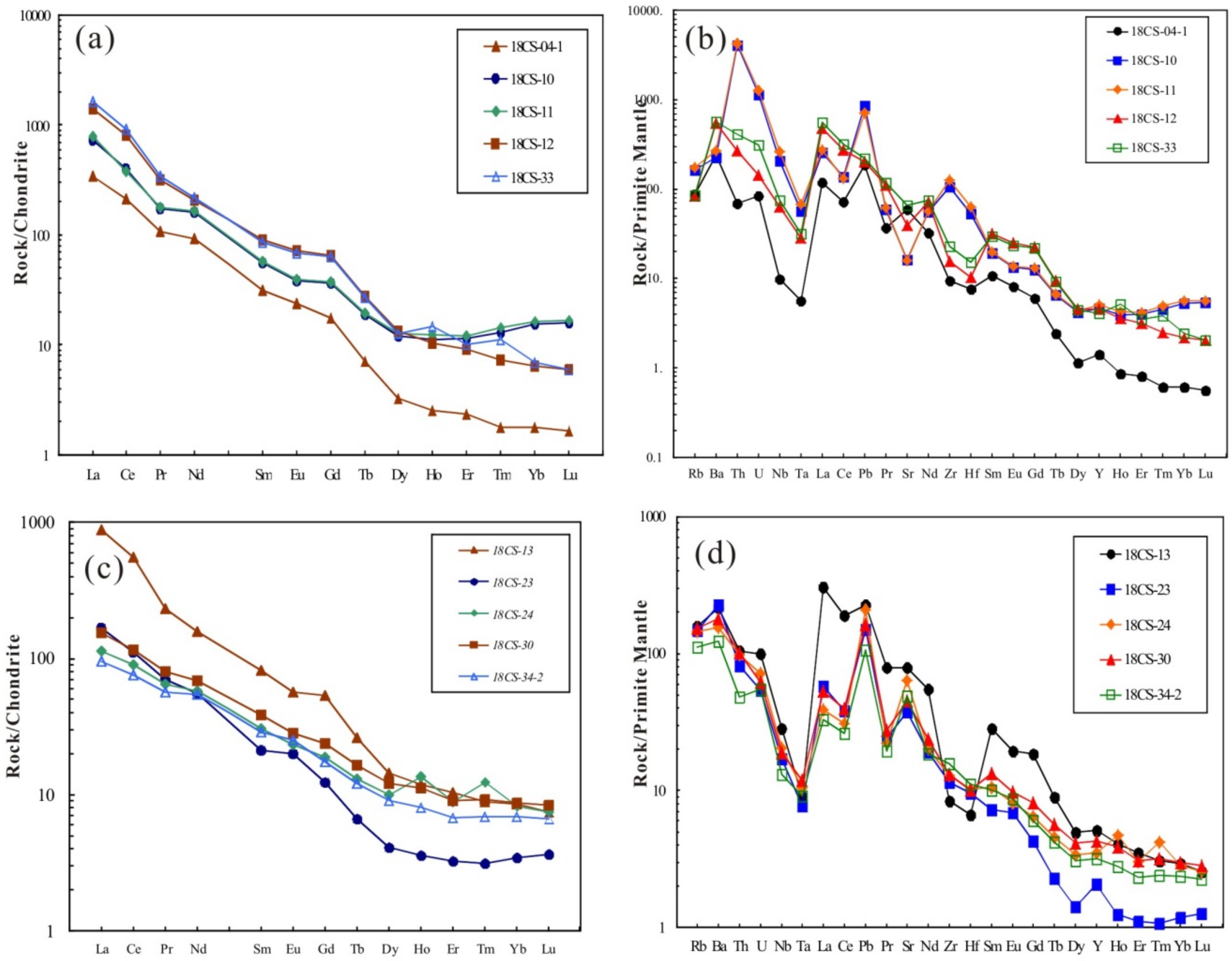
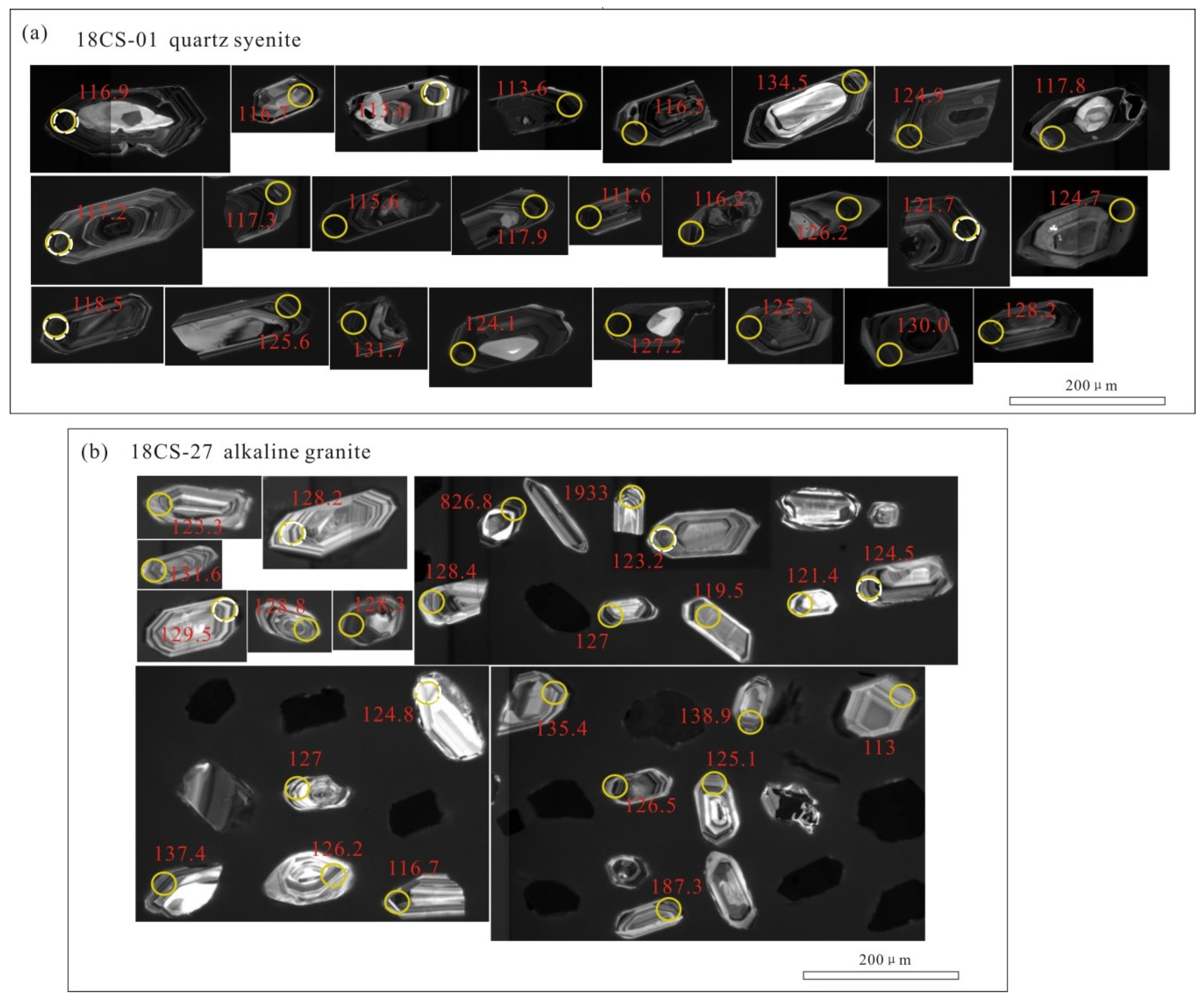

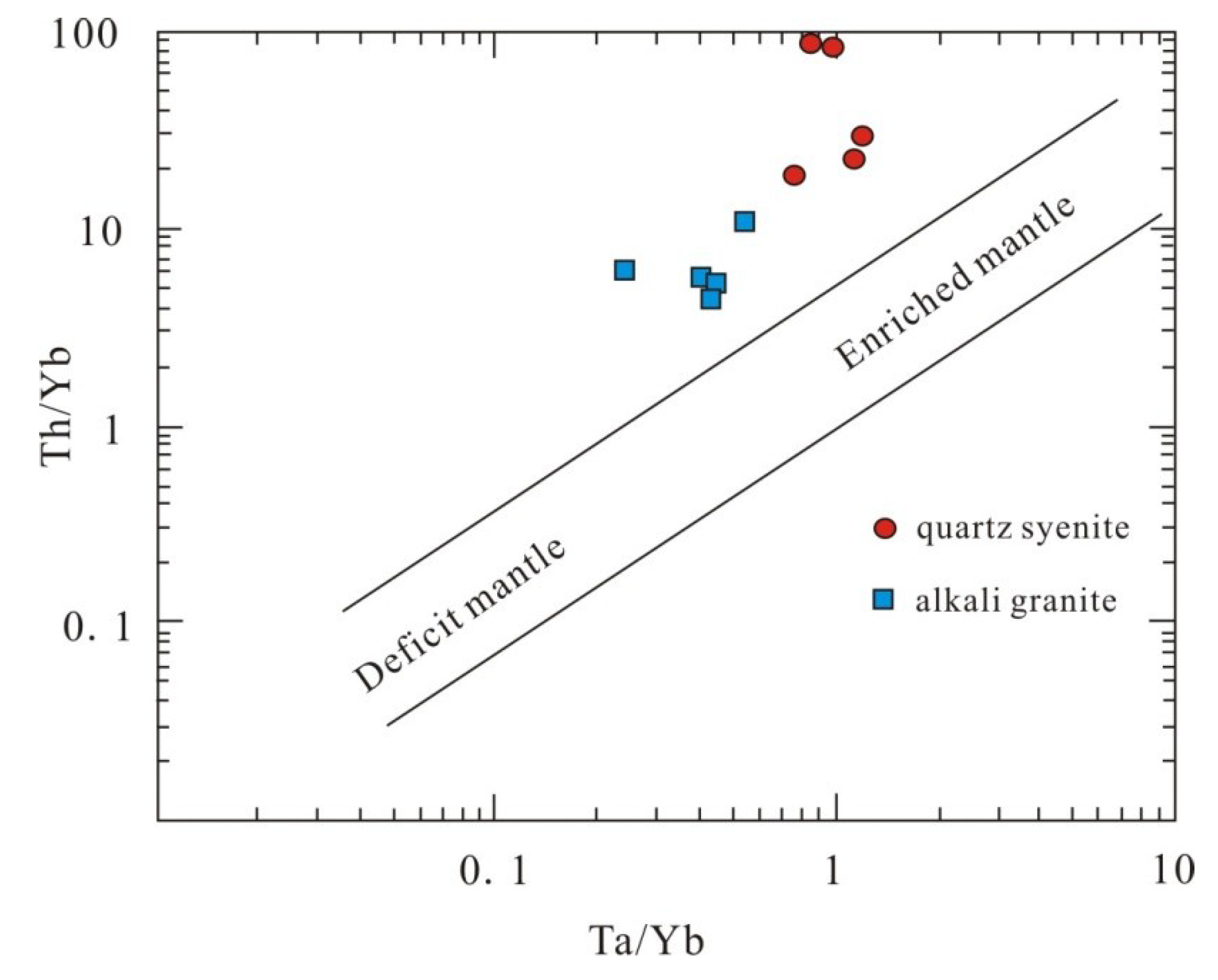
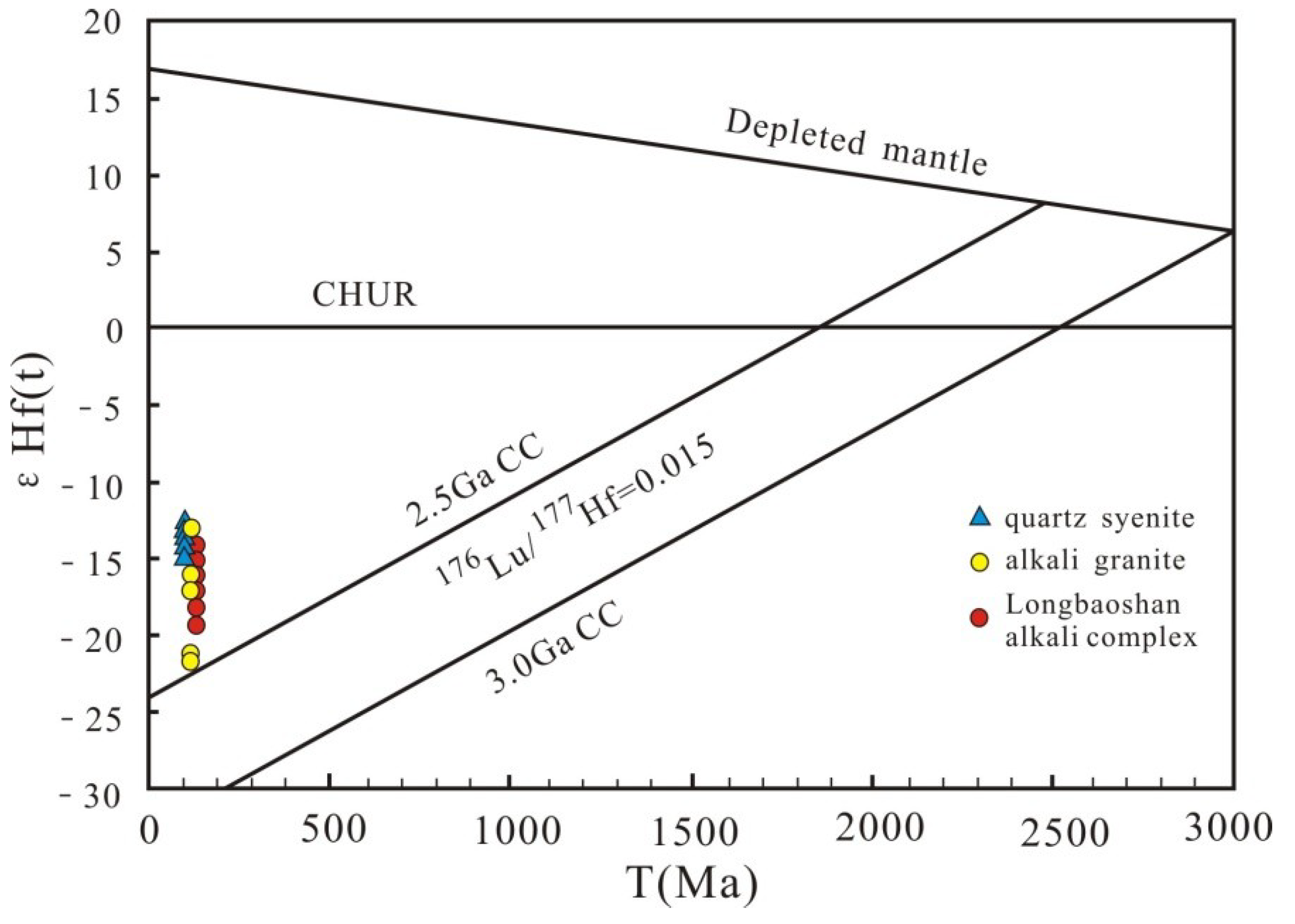
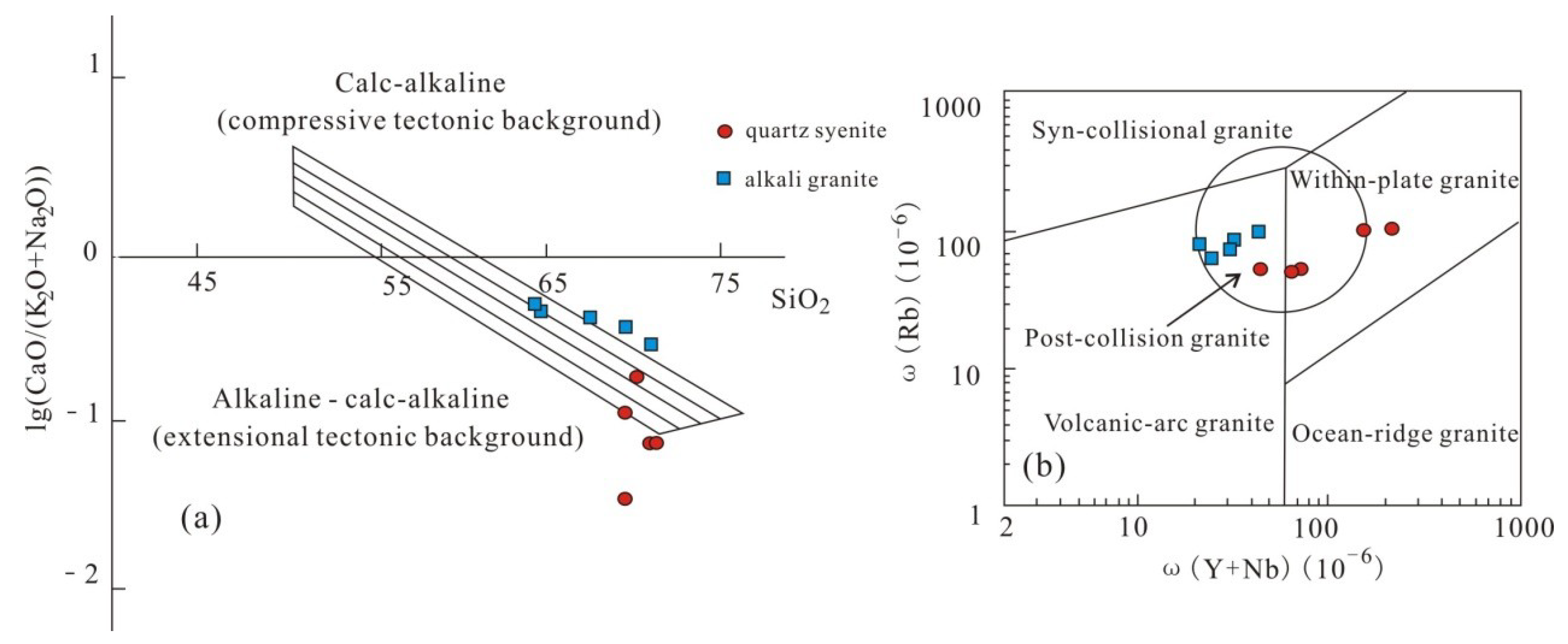
| Samples | 18CS-04-1 | 18CS-10 | 18CS-11 | 18CS-12 | 18CS-33 | 18CS-13 | 18CS-23 | 18CS-24 | 18CS-30 | 18CS-34-2 |
|---|---|---|---|---|---|---|---|---|---|---|
| quartz syenite | alkali granite | |||||||||
| SiO2 | 70.20 | 71.35 | 71.72 | 69.02 | 69.42 | 69.55 | 71.66 | 64.44 | 67.13 | 64.07 |
| Al2O3 | 15.25 | 13.74 | 13.51 | 16.12 | 15.41 | 14.07 | 14.70 | 16.50 | 15.09 | 16.75 |
| MgO | 0.49 | 0.16 | 0.19 | 0.15 | 0.48 | 0.62 | 0.71 | 1.39 | 1.33 | 1.55 |
| Na2O | 5.53 | 6.25 | 6.12 | 7.13 | 7.11 | 4.76 | 4.64 | 6.20 | 4.99 | 5.91 |
| K2O | 3.34 | 4.29 | 4.43 | 3.82 | 3.67 | 3.59 | 3.20 | 2.08 | 2.95 | 1.70 |
| P2O5 | 0.07 | 0.03 | 0.04 | 0.10 | 0.11 | 0.09 | 0.09 | 0.18 | 0.11 | 0.20 |
| TiO2 | 0.17 | 0.08 | 0.06 | 0.11 | 0.11 | 0.19 | 0.19 | 0.36 | 0.32 | 0.40 |
| CaO | 1.59 | 0.73 | 0.74 | 0.38 | 1.15 | 3.03 | 2.32 | 3.78 | 3.32 | 4.14 |
| TFe2O3 | 1.32 | 2.35 | 2.31 | 1.38 | 1.50 | 1.74 | 1.93 | 3.75 | 3.19 | 4.19 |
| FeO | 0.76 | 0.39 | 0.39 | 0.12 | 0.37 | 0.89 | 1.08 | 1.70 | 1.50 | 1.83 |
| Fe2O3 | 0.48 | 1.92 | 1.87 | 1.25 | 1.09 | 0.76 | 0.73 | 1.87 | 1.52 | 2.16 |
| MnO | 0.02 | 0.13 | 0.12 | 0.05 | 0.05 | 0.09 | 0.04 | 0.08 | 0.07 | 0.07 |
| LOI | 2.45 | 0.77 | 0.71 | 0.96 | 0.63 | 2.00 | 0.68 | 1.36 | 1.60 | 1.17 |
| Total | 100.43 | 99.87 | 99.94 | 99.21 | 99.65 | 99.73 | 100.15 | 100.13 | 100.10 | 100.14 |
| Na2O + K2O | 8.87 | 10.53 | 10.56 | 10.94 | 10.78 | 8.35 | 7.84 | 8.28 | 7.94 | 7.62 |
| A/NK | 1.199 | 0.921 | 0.908 | 1.017 | 0.983 | 1.2 | 1.325 | 1.325 | 1.324 | 1.447 |
| A/CNK | 0.977 | 0.846 | 0.833 | 0.974 | 0.867 | 0.816 | 0.96 | 0.854 | 0.865 | 0.877 |
| AR | 3.23 | 6.36 | 6.73 | 4.94 | 4.73 | 2.91 | 2.71 | 2.38 | 2.51 | 2.15 |
| Rb | 54.93 | 102.57 | 109.93 | 52.93 | 54.15 | 103.24 | 94.02 | 92.16 | 97.01 | 71.09 |
| Sr | 1235.82 | 339.67 | 337.60 | 830.67 | 1381.18 | 1670.70 | 793.43 | 1354.19 | 945.03 | 1027.48 |
| Ba | 1694.82 | 1572.33 | 1866.33 | 3825.37 | 3975.62 | 1539.17 | 1572.63 | 1075.93 | 1245.54 | 856.73 |
| Th | 5.80 | 342.33 | 362.58 | 23.00 | 34.86 | 9.64 | 6.94 | 8.37 | 8.63 | 4.06 |
| U | 1.77 | 23.87 | 26.92 | 2.99 | 6.55 | 1.87 | 1.13 | 1.50 | 1.30 | 1.16 |
| Nb | 7.09 | 148.94 | 187.67 | 44.96 | 53.76 | 17.12 | 12.23 | 14.60 | 13.35 | 9.38 |
| Ta | 0.23 | 2.30 | 2.75 | 1.16 | 1.29 | 0.39 | 0.32 | 0.43 | 0.49 | 0.37 |
| Zr | 106.19 | 1196.82 | 1413.12 | 175.74 | 255.58 | 87.80 | 128.83 | 143.37 | 146.91 | 174.67 |
| Hf | 2.35 | 16.56 | 19.43 | 3.16 | 4.67 | 1.96 | 2.97 | 3.16 | 3.09 | 3.46 |
| Co | 4.62 | 1.82 | 1.32 | 2.35 | 3.45 | 5.59 | 6.43 | 12.59 | 13.08 | 16.41 |
| Ni | 3.27 | 14.14 | 1.99 | 4.01 | 9.86 | 4.79 | 4.83 | 12.95 | 14.50 | 13.17 |
| Cr | 12.69 | 29.35 | 10.00 | 18.35 | 19.12 | 12.65 | 11.27 | 13.84 | 25.16 | 13.75 |
| V | 23.75 | 32.94 | 31.11 | 25.39 | 27.36 | 29.32 | 34.95 | 57.90 | 52.34 | 78.94 |
| Sc | 7.15 | 6.38 | 6.99 | 8.74 | 7.85 | 6.58 | 5.80 | 9.76 | 13.28 | 16.56 |
| Cs | 0.91 | 0.27 | 0.32 | 0.18 | 0.22 | 1.65 | 1.78 | 2.86 | 2.25 | 2.23 |
| Ga | 58.10 | 60.66 | 61.71 | 67.52 | 46.97 | 55.99 | 45.02 | 59.30 | 50.84 | 58.69 |
| Cu | 9.62 | 8.52 | 8.03 | 6.73 | 5.69 | 10.58 | 5.18 | 7.36 | 45.68 | 21.13 |
| Pb | 13.27 | 61.06 | 50.37 | 14.47 | 15.78 | 14.20 | 10.64 | 14.83 | 11.47 | 7.55 |
| Zn | 36.49 | 99.67 | 104.08 | 37.83 | 73.80 | 41.55 | 35.42 | 65.29 | 60.14 | 64.96 |
| Be | 2.30 | 17.92 | 18.15 | 3.89 | 4.89 | 1.98 | 1.90 | 2.37 | 2.34 | 2.12 |
| La | 81.50 | 174.62 | 187.46 | 330.85 | 383.69 | 219.65 | 39.33 | 26.67 | 36.75 | 22.78 |
| Ce | 128.85 | 244.16 | 231.99 | 489.15 | 560.84 | 347.44 | 67.59 | 54.80 | 70.24 | 46.35 |
| Pr | 10.20 | 16.42 | 16.97 | 30.48 | 32.84 | 22.83 | 6.62 | 6.13 | 7.57 | 5.41 |
| Nd | 43.37 | 74.72 | 76.91 | 97.28 | 101.77 | 77.68 | 25.97 | 27.17 | 32.22 | 25.25 |
| Sm | 4.78 | 8.64 | 8.78 | 13.91 | 13.26 | 13.28 | 3.22 | 4.66 | 5.93 | 4.44 |
| Eu | 1.38 | 2.23 | 2.29 | 4.15 | 3.94 | 3.46 | 1.16 | 1.36 | 1.64 | 1.45 |
| Gd | 3.58 | 7.52 | 7.73 | 13.43 | 13.04 | 11.43 | 2.53 | 3.85 | 4.85 | 3.58 |
| Tb | 0.26 | 0.70 | 0.73 | 1.03 | 1.00 | 1.02 | 0.25 | 0.49 | 0.61 | 0.45 |
| Dy | 0.83 | 3.08 | 3.21 | 3.36 | 3.25 | 3.84 | 1.05 | 2.51 | 3.06 | 2.28 |
| Ho | 0.14 | 0.64 | 0.70 | 0.58 | 0.84 | 0.72 | 0.20 | 0.77 | 0.63 | 0.46 |
| Er | 0.39 | 1.89 | 1.99 | 1.51 | 1.67 | 1.77 | 0.53 | 1.46 | 1.49 | 1.12 |
| Tm | 0.04 | 0.33 | 0.36 | 0.18 | 0.28 | 0.24 | 0.08 | 0.31 | 0.24 | 0.18 |
| Yb | 0.30 | 2.61 | 2.77 | 1.08 | 1.19 | 1.52 | 0.59 | 1.40 | 1.48 | 1.16 |
| Lu | 0.04 | 0.40 | 0.42 | 0.15 | 0.15 | 0.20 | 0.09 | 0.19 | 0.21 | 0.17 |
| Y | 6.44 | 21.15 | 22.93 | 20.51 | 18.35 | 24.60 | 9.42 | 15.97 | 19.39 | 14.44 |
| ∑REE | 275.68 | 537.98 | 542.32 | 987.16 | 1117.77 | 705.08 | 149.20 | 131.77 | 166.91 | 115.08 |
| LREE/HREE | 18.11 | 19.12 | 17.56 | 21.40 | 17.17 | 18.14 | 5.04 | 2.70 | 7.21 | 2.95 |
| LaN/YbN | 31.99 | 41.74 | 35.56 | 31.51 | 23.52 | 38.04 | 3.33 | 1.59 | 5.73 | 1.73 |
| δEu | 1.36 | 1.56 | 2.30 | 1.35 | 2.53 | 1.28 | 0.93 | 2.35 | 7.37 | 1.42 |
| Samples | Content(10−6) | 232Th/238U | Ratio/1sigma | Age(Ma)/1sigma | Concord-Ance | ||||||||||||
|---|---|---|---|---|---|---|---|---|---|---|---|---|---|---|---|---|---|
| Th232 | U238 | Pb | 207Pb/206Pb | (1σ) | 207Pb/235U | (1σ) | 206Pb/238U | (1σ) | 207Pb/206Pb | (1σ) | 207Pb/235U | (1σ) | 206Pb/238U | (1σ) | |||
| 18CS-01-01 | 472.266 | 1574.096 | 72.42149 | 0.013808 | 0.047655 | 0.0008 | 0.120187 | 0.001995 | 0.018313 | 0.000146 | 83.425 | 42.5875 | 115.2415 | 1.807961 | 116.9831 | 0.926284 | 98% |
| 18CS-01-02 | 141.3717 | 484.5583 | 22.00171 | 0.045451 | 0.048555 | 0.0015 | 0.121936 | 0.00375 | 0.018278 | 0.00019 | 127.865 | 77.7675 | 116.8258 | 3.394018 | 116.7661 | 1.200294 | 99% |
| 18CS-01-03 | 112.2566 | 536.1725 | 19.61299 | 0.050986 | 0.049164 | 0.0013 | 0.119702 | 0.00321 | 0.017678 | 0.000192 | 166.75 | 60.175 | 114.8018 | 2.911336 | 112.9642 | 1.216271 | 98% |
| 18CS-01-04 | 899.1592 | 2338.122 | 124.8586 | 0.008009 | 0.050982 | 0.0008 | 0.124976 | 0.00207 | 0.017779 | 0.000154 | 238.955 | 32.4025 | 119.5729 | 1.868731 | 113.6043 | 0.977245 | 94% |
| 18CS-01-05 | 356.5362 | 1040.718 | 54.79529 | 0.018249 | 0.052719 | 0.0016 | 0.132715 | 0.004329 | 0.018234 | 0.000151 | 316.725 | 72.215 | 126.5343 | 3.880344 | 116.484 | 0.958009 | 91% |
| 18CS-01-06 | 472.2965 | 1369.869 | 85.68922 | 0.011670 | 0.064813 | 0.0010 | 0.188885 | 0.003809 | 0.021084 | 0.000231 | 768.52 | 227.775 | 175.6776 | 3.252768 | 134.5061 | 1.460831 | 73% |
| 18CS-01-07 | 319.7484 | 1300.715 | 55.01009 | 0.018178 | 0.050943 | 0.0010 | 0.129436 | 0.002559 | 0.018442 | 0.000168 | 238.955 | 46.2875 | 123.5911 | 2.300364 | 117.8035 | 1.064738 | 95% |
| 18CS-01-08 | 318.2334 | 745.503 | 40.82856 | 0.024492 | 0.049643 | 0.0011 | 0.125423 | 0.00292 | 0.018346 | 0.000172 | 188.97 | 53.695 | 119.977 | 2.634657 | 117.1929 | 1.088303 | 97% |
| 18CS-01-09 | 456.0166 | 1273.565 | 63.5378 | 0.015738 | 0.047779 | 0.0007 | 0.121213 | 0.002327 | 0.018359 | 0.000169 | 87.13 | 37.0325 | 116.1708 | 2.107511 | 117.278 | 1.069839 | 99% |
| 18CS-01-10 | 1128.152 | 1975.129 | 133.8668 | 0.007470 | 0.053944 | 0.0008 | 0.134592 | 0.002222 | 0.01809 | 0.000142 | 368.57 | 67.585 | 128.2157 | 1.988704 | 115.5733 | 0.898444 | 89% |
| 18CS-01-11 | 651.9653 | 1577.681 | 86.08203 | 0.011616 | 0.04734 | 0.0008 | 0.120433 | 0.002483 | 0.018459 | 0.000219 | 64.91 | 44.44 | 115.4646 | 2.249844 | 117.9099 | 1.387347 | 97% |
| 18CS-01-12 | 898.3659 | 2328.23 | 124.3088 | 0.008044 | 0.053159 | 0.0012 | 0.128194 | 0.003227 | 0.01747 | 0.000168 | 344.5 | 51.8475 | 122.4733 | 2.904556 | 111.6455 | 1.061992 | 90% |
| 18CS-01-13 | 788.5011 | 1671.612 | 103.3689 | 0.009674 | 0.050465 | 0.0009 | 0.132032 | 0.002546 | 0.019059 | 0.000271 | 216.74 | 44.435 | 125.922 | 2.283971 | 121.7033 | 1.71218 | 96% |
| 18CS-01-14 | 457.0531 | 1327.671 | 73.53172 | 0.013599 | 0.0583 | 0.0013 | 0.14635 | 0.003806 | 0.018185 | 0.000228 | 542.63 | 45.365 | 138.6842 | 3.371065 | 116.1738 | 1.443957 | 82% |
| 18CS-01-15 | 586.9446 | 1444.842 | 83.7469 | 0.011940 | 0.051583 | 0.0011 | 0.138845 | 0.002916 | 0.019556 | 0.000181 | 333.39 | 53.6975 | 132.0148 | 2.599895 | 124.8503 | 1.146076 | 94% |
| 18CS-01-16 | 1575.995 | 1557.102 | 167.3218 | 0.005976 | 0.052591 | 0.0011 | 0.134521 | 0.00305 | 0.018556 | 0.000209 | 322.28 | 52.7725 | 128.1519 | 2.729537 | 118.5211 | 1.322501 | 92% |
| 18CS-01-17 | 332.9182 | 1256.546 | 57.44716 | 0.017407 | 0.051117 | 0.0011 | 0.138803 | 0.003422 | 0.019668 | 0.000177 | 255.62 | 53.695 | 131.9771 | 3.05101 | 125.558 | 1.116436 | 95% |
| 18CS-01-18 | 228.5987 | 1247.068 | 48.28645 | 0.020709 | 0.048046 | 0.0008 | 0.136866 | 0.002847 | 0.020647 | 0.000245 | 101.94 | 42.59 | 130.249 | 2.542711 | 131.7423 | 1.54961 | 98% |
| 18CS-01-19 | 823.7941 | 1948.765 | 108.8157 | 0.009189 | 0.048503 | 0.0007 | 0.130254 | 0.002346 | 0.019449 | 0.000167 | 124.16 | 37.0325 | 124.3262 | 2.107497 | 124.1746 | 1.058586 | 99% |
| 18CS-01-20 | 660.8823 | 1571.493 | 90.21077 | 0.011085 | 0.048625 | 0.0008 | 0.133771 | 0.002641 | 0.019933 | 0.000173 | 131.57 | 42.5875 | 127.4804 | 2.365375 | 127.2304 | 1.094315 | 99% |
| 18CS-01-21 | 420.7892 | 1471.985 | 65.17453 | 0.015343 | 0.047701 | 0.0007 | 0.129111 | 0.002201 | 0.019633 | 0.000218 | 83.425 | 32.405 | 123.2988 | 1.97913 | 125.3364 | 1.377201 | 98% |
| 18CS-01-22 | 156.5514 | 737.5803 | 28.84884 | 0.034663 | 0.049044 | 0.0011 | 0.137333 | 0.003077 | 0.02037 | 0.000237 | 150.085 | 58.325 | 130.6653 | 2.74676 | 129.9958 | 1.496093 | 99% |
| 18CS-01-23 | 278.1643 | 755.6438 | 39.65799 | 0.025215 | 0.048441 | 0.0010 | 0.134069 | 0.003091 | 0.020085 | 0.00019 | 120.46 | 47.2175 | 127.7476 | 2.767645 | 128.1955 | 1.199058 | 99% |
| 18CS-01-24 | 431.8319 | 1024.951 | 53.68663 | 0.018626 | 0.049214 | 0.0010 | 0.134265 | 0.003093 | 0.019769 | 0.000208 | 166.75 | 48.14 | 127.9231 | 2.768721 | 126.1937 | 1.315243 | 98% |
| 18CS-01-25 | 542.2902 | 1066.892 | 70.0304 | 0.014279 | 0.052021 | 0.0011 | 0.140767 | 0.003797 | 0.019538 | 0.000195 | 287.1 | 54.625 | 133.7268 | 3.379782 | 124.7336 | 1.231627 | 93% |
| 18CS-27-01 | 417.35 | 574.775 | 50.98 | 0.01962 | 0.0529 | 0.0015 | 0.1409 | 0.004 | 0.0193 | 0.0002 | 324.13 | 62.96 | 133.83 | 3.4989 | 123.3 | 1.0768 | 91% |
| 18CS-27-02 | 206.17 | 391.128 | 28.38 | 0.03524 | 0.0512 | 0.0016 | 0.1421 | 0.005 | 0.02008 | 0.0002 | 255.62 | 74.06 | 134.91 | 4.6077 | 128.2 | 1.4283 | 94% |
| 18CS-27-03 | 401.89 | 638.972 | 101 | 0.0099 | 0.1234 | 0.004 | 0.3537 | 0.013 | 0.02063 | 0.0002 | 2005.3 | 58.02 | 307.52 | 9.8711 | 131.6 | 1.3585 | 19% |
| 18CS-27-04 | 1575.8 | 989.838 | 173.7 | 0.00576 | 0.0512 | 0.001 | 0.142 | 0.003 | 0.0201 | 0.0002 | 250.07 | 43.51 | 134.86 | 2.8708 | 128.3 | 1.4591 | 94% |
| 18CS-27-05 | 280.19 | 391.704 | 37.03 | 0.027 | 0.0471 | 0.0014 | 0.1315 | 0.004 | 0.02029 | 0.0002 | 53.8 | 66.66 | 125.46 | 3.4071 | 129.5 | 1.3713 | 96% |
| 18CS-27-06 | 686.96 | 449.545 | 74.51 | 0.01342 | 0.0541 | 0.002 | 0.1504 | 0.006 | 0.02018 | 0.0003 | 375.98 | 85.18 | 142.27 | 5.1808 | 128.8 | 2.026 | 90% |
| 18CS-27-07 | 147.02 | 323.972 | 21.98 | 0.0455 | 0.0539 | 0.0025 | 0.1567 | 0.007 | 0.02123 | 0.0003 | 364.87 | 110.2 | 147.84 | 5.9398 | 135.4 | 1.7638 | 91% |
| 18CS-27-08 | 406.1 | 671.044 | 56.57 | 0.01768 | 0.0542 | 0.0018 | 0.1477 | 0.004 | 0.01982 | 0.0003 | 388.94 | 75.92 | 139.88 | 3.9736 | 126.5 | 1.7396 | 89% |
| 18CS-27-09 | 708.24 | 531.91 | 321.2 | 0.00311 | 0.3259 | 0.0103 | 1.3329 | 0.067 | 0.02948 | 0.0008 | 3598.1 | 48.22 | 860.14 | 29.004 | 187.3 | 4.9803 | −29% |
| 18CS-27-10 | 497.94 | 520.623 | 65.74 | 0.01521 | 0.0583 | 0.0022 | 0.1574 | 0.006 | 0.0196 | 0.0002 | 542.63 | 83.32 | 148.41 | 5.2574 | 125.1 | 1.4374 | 82% |
| 18CS-27-11 | 495.14 | 480.37 | 92 | 0.01087 | 0.1088 | 0.0038 | 0.3258 | 0.011 | 0.02177 | 0.0003 | 1788.9 | 64.51 | 286.38 | 8.7345 | 138.9 | 1.5795 | 30% |
| 18CS-27-12 | 344.03 | 316.666 | 36.02 | 0.02776 | 0.053 | 0.0023 | 0.1289 | 0.006 | 0.01769 | 0.0002 | 327.84 | 99.99 | 123.07 | 5.0352 | 113 | 1.1601 | 91% |
| 18CS-27-13 | 403.35 | 361.82 | 52.96 | 0.01888 | 0.0542 | 0.002 | 0.1606 | 0.006 | 0.02155 | 0.0003 | 388.94 | 81.47 | 151.21 | 4.9154 | 137.4 | 1.7486 | 90% |
| 18CS-27-14 | 329.94 | 493.923 | 39.33 | 0.02542 | 0.0531 | 0.0018 | 0.146 | 0.005 | 0.0199 | 0.0003 | 344.5 | 74.07 | 138.41 | 4.6296 | 127 | 1.5806 | 91% |
| 18CS-27-15 | 187.46 | 249.474 | 183.4 | 0.00545 | 0.0736 | 0.0012 | 1.6201 | 0.025 | 0.15983 | 0.0015 | 1031.5 | 31.95 | 978.03 | 9.6871 | 955.8 | 8.5274 | 97% |
| 18CS-27-16 | 549.1 | 370.138 | 60.88 | 0.01643 | 0.0504 | 0.0021 | 0.1374 | 0.006 | 0.01976 | 0.0002 | 213.04 | 91.65 | 130.71 | 5.3468 | 126.2 | 1.4083 | 96% |
| 18CS-27-17 | 234.19 | 784.505 | 35.75 | 0.02798 | 0.0493 | 0.0014 | 0.1238 | 0.003 | 0.01827 | 0.0002 | 161.2 | 66.66 | 118.49 | 3.1387 | 116.7 | 1.1585 | 98% |
| 18CS-27-18 | 391.19 | 527.786 | 54.24 | 0.01844 | 0.0569 | 0.0016 | 0.1581 | 0.005 | 0.02012 | 0.0003 | 487.08 | 58.33 | 149 | 4.3331 | 128.4 | 1.6889 | 85% |
| 18CS-27-19 | 82.005 | 878.631 | 237.1 | 0.00422 | 0.1403 | 0.0018 | 2.6566 | 0.068 | 0.13684 | 0.0026 | 2231.5 | 22.07 | 1316.5 | 18.848 | 826.8 | 14.47 | 54% |
| 18CS-27-20 | 506.93 | 324.127 | 814.7 | 0.00123 | 0.1664 | 0.002 | 8.0428 | 0.221 | 0.3497 | 0.0078 | 2521.3 | 20.83 | 2235.8 | 24.777 | 1933 | 37.16 | 85% |
| 18CS-27-21 | 380.77 | 680.57 | 49.65 | 0.02014 | 0.0495 | 0.0014 | 0.1316 | 0.004 | 0.01929 | 0.0002 | 172.31 | 66.66 | 125.52 | 3.4689 | 123.2 | 1.0877 | 98% |
| 18CS-27-22 | 633.59 | 522.519 | 72.68 | 0.01376 | 0.053 | 0.0024 | 0.1455 | 0.007 | 0.01989 | 0.0003 | 327.84 | 97.21 | 137.93 | 6.069 | 127 | 1.9475 | 91% |
| 18CS-27-23 | 960.9 | 598.913 | 99.37 | 0.01006 | 0.0504 | 0.0014 | 0.1299 | 0.003 | 0.01871 | 0.0002 | 213.04 | 66.66 | 124.04 | 3.129 | 119.5 | 1.102 | 96% |
| 18CS-27-24 | 366.76 | 391.313 | 45.96 | 0.02176 | 0.066 | 0.0028 | 0.1724 | 0.007 | 0.01902 | 0.0002 | 809.26 | 88.89 | 161.52 | 5.6966 | 121.4 | 1.503 | 71% |
| 18CS-27-25 | 1361.7 | 1031.35 | 149.1 | 0.00671 | 0.0483 | 0.0009 | 0.1301 | 0.003 | 0.01951 | 0.0002 | 122.31 | 44.44 | 124.18 | 2.4746 | 124.5 | 1.3435 | 99% |
| Samples | 176Yb/177Hf | 176Lu/177Hf | 176Hf/177Hf | 2σ | εHf(0) | εHf(t) | TDM(Ma) | TDMC(Ma) | fLu/Hf |
|---|---|---|---|---|---|---|---|---|---|
| 18CS01-01 | 0.013407 | 0.000586 | 0.282297 | 0.000018 | −16.8 | −14.1 | 1334 | 2078 | −0.98 |
| 18CS01-03 | 0.015576 | 0.000718 | 0.282282 | 0.000029 | −17.3 | −14.6 | 1359 | 2112 | −0.98 |
| 18CS01-08 | 0.013584 | 0.000573 | 0.282248 | 0.000025 | −18.5 | −15.8 | 1400 | 2186 | −0.98 |
| 18CS01-13 | 0.011379 | 0.000519 | 0.282322 | 0.000019 | −15.9 | −13.2 | 1296 | 2020 | −0.98 |
| 18CS01-16 | 0.022202 | 0.000943 | 0.282299 | 0.000021 | −16.7 | −14.0 | 1343 | 2074 | −0.97 |
| 18CS-27-02 | 0.020686 | 0.001017 | 0.282241 | 0.000018 | −18.8 | −16.1 | 1426 | 2203 | −0.97 |
| 18CS-27-05 | 0.022520 | 0.001098 | 0.282317 | 0.000023 | −16.1 | −13.4 | 1324 | 2036 | −0.97 |
| 18CS-27-15 | 0.040275 | 0.001565 | 0.282200 | 0.000025 | −20.2 | −17.6 | 1505 | 2298 | −0.95 |
| 18CS-27-21 | 0.017104 | 0.000765 | 0.282055 | 0.000022 | −25.4 | −22.7 | 1675 | 2617 | −0.98 |
| 18CS-27-25 | 0.022610 | 0.000942 | 0.282062 | 0.000024 | −25.1 | −22.4 | 1672 | 2601 | −0.97 |
© 2019 by the authors. Licensee MDPI, Basel, Switzerland. This article is an open access article distributed under the terms and conditions of the Creative Commons Attribution (CC BY) license (http://creativecommons.org/licenses/by/4.0/).
Share and Cite
Wei, P.; Yu, X.; Li, D.; Liu, Q.; Yu, L.; Li, Z.; Geng, K.; Zhang, Y.; Sun, Y.; Chi, N. Geochemistry, Zircon U–Pb Geochronology, and Lu–Hf Isotopes of the Chishan Alkaline Complex, Western Shandong, China. Minerals 2019, 9, 293. https://doi.org/10.3390/min9050293
Wei P, Yu X, Li D, Liu Q, Yu L, Li Z, Geng K, Zhang Y, Sun Y, Chi N. Geochemistry, Zircon U–Pb Geochronology, and Lu–Hf Isotopes of the Chishan Alkaline Complex, Western Shandong, China. Minerals. 2019; 9(5):293. https://doi.org/10.3390/min9050293
Chicago/Turabian StyleWei, Pengfei, Xuefeng Yu, Dapeng Li, Qiang Liu, Lidong Yu, Zengsheng Li, Ke Geng, Yan Zhang, Yuqin Sun, and Naijie Chi. 2019. "Geochemistry, Zircon U–Pb Geochronology, and Lu–Hf Isotopes of the Chishan Alkaline Complex, Western Shandong, China" Minerals 9, no. 5: 293. https://doi.org/10.3390/min9050293
APA StyleWei, P., Yu, X., Li, D., Liu, Q., Yu, L., Li, Z., Geng, K., Zhang, Y., Sun, Y., & Chi, N. (2019). Geochemistry, Zircon U–Pb Geochronology, and Lu–Hf Isotopes of the Chishan Alkaline Complex, Western Shandong, China. Minerals, 9(5), 293. https://doi.org/10.3390/min9050293




